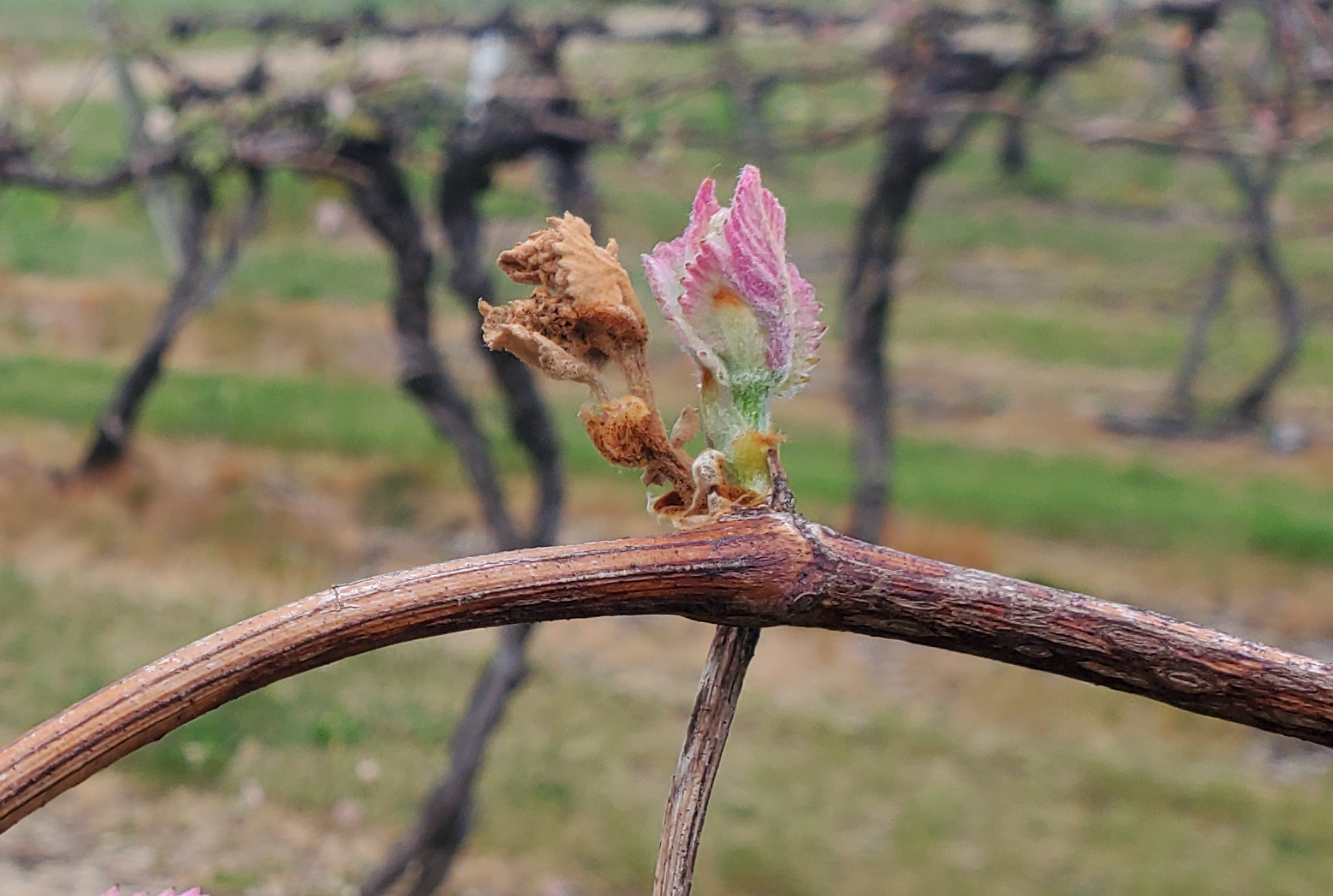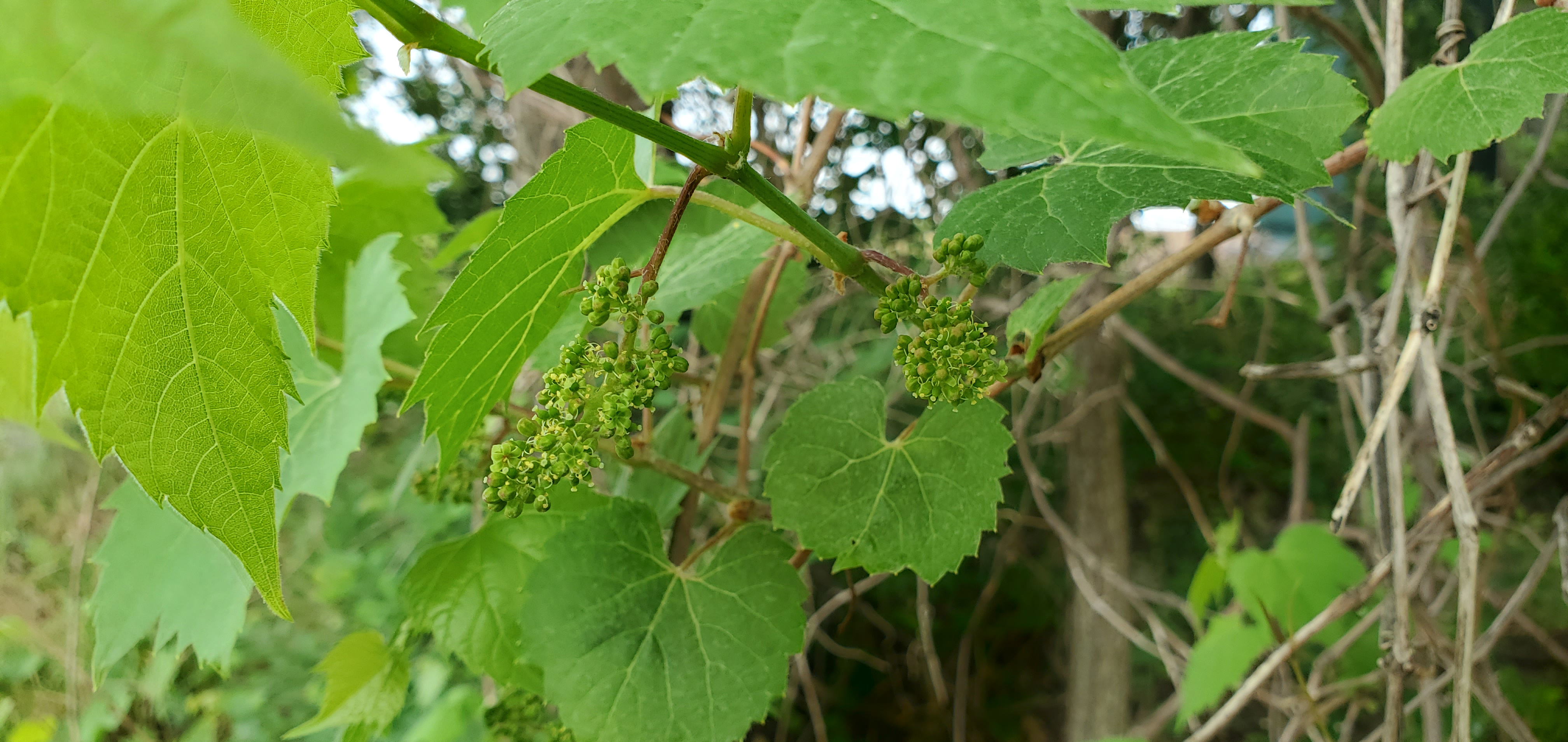Michigan grape scouting report – May 26, 2021
Heat from the past week helped grapes move quickly. Shoots are lengthening throughout Michigan and clusters are becoming visible.

Weather
Last week was hot! Highs were in the 80s. Lows were in the 60s. Northern grape growing areas saw a break in the temperatures over the weekend, with temperatures dropping 10-15 degrees Fahrenheit by Monday. The southwest grape growing areas reported no rain in the past week. The rest of the state got up to two-tenths of an inch of rain. Soils are very dry, especially in southern portions of the state. At this time, most of lower Michigan is in a D1 level drought. Portions of Van Buren and all of Allegan counties and areas just to the north and east are in a D2 (severe) drought condition. This is extremely unusual at this time of year.
The next week is expected to be much cooler than the last. Two weather fronts will be moving through Michigan on Wednesday and Friday, bringing rain and a drop in temperatures. Friday should be the coldest day this coming week with highs in the 50s statewide. Scattered frosts will be a concern in low spots on Thursday, Friday and Saturday mornings in northwestern areas of Michigan. Otherwise, expect highs in the mid-60s and lows in the 40s.
With the hot week, we picked up a lot of growing degree days (GDD) last week: 120-150 GDD base 50. The southwest region is 170 GDD base 50 ahead of the northwest region. Statewide, we are 100-140 GDD base 50 ahead of the five-year average.
|
Northwest Michigan GDD summary from March 1 - May 24, 2021 | |
|---|---|
|
Northwest stations |
GDD 50 F |
|
Petoskey (Petoskey) |
248 |
|
Traverse City (NWMHRC) |
269 |
|
Old Mission (Old Mission) |
257 |
|
Average for northwest region |
262 |
|
Average last week |
144 |
|
Southern stations |
GDD 50 F |
|
Benton Harbor (SWMREC) |
443 |
|
Lawton (Lawton) |
448 |
|
Fennville (TNRC) |
362 |
|
Average for southwest region |
433 |
|
Average last week |
284 |
|
Romeo (Romeo) |
399 |
|
Average for southeast region |
419 |
|
Average last week |
281 |
Vine growth
In the southwest, a lot of variability exists between vineyards. A series of classic radiation frost/freeze events starting the morning of May 5 and continuing through May 14 caused damage to grapes in many parts of southwest Michigan. Those sites impacted by the freezes had varying levels of primary bud loss or foliar damage, with some areas as high as 70%. In many of these sites, secondary buds are beginning to emerge and are up to an inch long. In these freeze damaged sites, a reduced pest and disease program may be warranted. See “Pest management approaches in a winter or freeze damaged grape vineyard” from Michigan State University Extension for recommendations.
In sites not damaged by the freezes, shoot growth accelerated this past week. Shoots are 10-18 inches long in many areas. Clusters are expanding. Bloom on early varieties may be soon. This year, very little difference in phenological stages can be observed between juice, hybrid, and vinifera grapes. Variability is more due to site specifics (elevation, slope, distance from lake, etc.).

In northern vineyards, most vinifera have accelerated growth in the warm weather as well. Many sites have shoots that are 3-6 inches long. Clusters are starting to be visible. The northwest had similar temperatures during early May, but the grapes were behind phenologically when compared to vines in the southwest, so they have survived the spring cold events without any significant damage.

See this chart for grape growth stages.
Horticulture
A quality soil test or a previous year’s petiole analysis is important in understanding what nutrients the vineyard needs. Early season nutrient management will most likely include nitrogen, zinc and boron. In addition, potassium and magnesium may also need to be managed at this time. Be careful with the amount of nitrogen applied in your vineyard. Too much can cause flowering to be delayed or aborted and increase vegetative growth with detrimental effects on fruit quality (canopy shading) and cold hardiness and sensitivity to foliar and cluster diseases. Too little nitrogen will result in reduced vigor, stunted growth and poor fruit quality.
Shoot thinning has begun in southern vineyards now and may begin in northern vineyards in the next week or two. Shoot thinning is an important canopy management tool to improve air circulation, minimize disease pressure, reduce shading and improve spray penetration. The right time for shoot thinning time is when the shoots are 5-12 inches long.
For vinifera cultivars, it is recommended to leave between 3 to 5 shoots per foot of canopy, with fewer shoots in red varieties and more in white varieties. Hybrid cultivars are more vigorous and ripen earlier, so it is suggested to leave 4 to 6 shoots per linear foot of canopy, for higher levels of yield per acre.
For Concord and other native cultivars, the number of shoots per foot of canopy can reach as many as 15 shoots, especially in divided canopy trellis systems.
Diseases
At this time of year, disease focus is on phomopsis, black rot, anthracnose and powdery mildew. These diseases overwinter on trunks and canes. Dormant sprays in the fall or spring can help to manage them before the season starts, but this window is closed for the year.
Once shoots have expanded contact fungicides that include broad-spectrum/contact fungicides like the EBDCs (FRAC M3) and captan are effective and function similar to dormant applications by sanitizing the vineyard before bloom. For organic growers, early season oils may also be used, which try to suffocate overwintering fungal spores and infected tissues.
Early season management should target phomopsis, black rot, anthracnose and powdery mildew and as we approach bloom, downy mildew. With the exception of powdery mildew, these spring disease infections typically require rain events. It only takes 0.1 inches of rain above 50 F to trigger a possible infection. Viticultural practices that reduce canopy wetness such as good irrigation timing, leaf removal and good weed management can reduce many of these diseases in a vineyard.
Typically, DMIs (FRAC 3), captan and EBDCs (FRAC M3) are effective for phomopsis, black rot, and anthracnose. If powdery mildew is the only concern, there are a number of products that are effective (FRAC codes 3, 7, 11, 13, U8, 50, and U13 as well as sulfur). A combination of fungicides containing these FRAC classes should also be effective while helping with resistance management.
With the cool, wet weather in the forecast, make sure plants are protected as we head into bloom, particularly from downy mildew cluster infections which are typically susceptible up to 12 days pre-bloom.
Insects
For southern Michigan grape growers, the insects to be on the lookout for at this time are rose chafer and potato leafhopper. Potato leafhopper have been reported on other crops in Michigan already, and so both should be expected in vineyards soon. These are only a challenge in certain sensitive winegrape cultivars. Rose chafers can be found feeding on leaves and clusters. Potato leafhoppers feed on the undersides of leaves. Most cultivars are very tolerant of potato leafhopper damage and control isn’t often warranted.
Tumid gallmaker was an issue for some growers in some susceptible vineyards last year during early cluster development. Scouting for early management is key for this insect. For small vineyards, hand picking and removing infestations can be an effective management technique. If there is a high infestation or if clusters are affected, Movento is an effective treatment. This should be applied at the first sign of infestation, typically right after bloom. Movento needs to penetrate the waxy leaf surface, so application with a penetrating adjuvant is essential to get control.
Male grape berry moth have been trapped for a few weeks in southwest Michigan. Wild grape bloom is used as biofix for grape berry moth models. Record the date when 50% of the clusters on wild grape are at 50% bloom. This date can be entered into the grape berry moth model in Enviroweather to predict when egglaying will start.
Two locations in Berrien County have already recorded wild grape bloom earlier this week. Wild grape bloom looks imminent at other locations in southwest Michigan as well. In southwest Michigan, protection of clusters from larvae is focused in late June or early July when egglaying by the second generation of this pest starts. In high pressure sites where this pest has been a problem in recent seasons, early treatment for protection of the clusters at bloom in mid-June may also be warranted.
Product selection can be guided by what other pests may be present, such as potato leafhopper, rose chafer, etc. Treatment recommendations for all of these insects can be found in the MSU Fruit Pest Management Guide (E-154).

Regional and national news outlets have been reporting on Brood X of the periodical cicada lately. This insect emerges once every 17 years. It is only expected in south central and southeastern portions of Michigan but is not expected to be an issue for growers. We do not expect periodical cicadas to be a significant concern for grape growers in Michigan, but if you are interested, check out this article on the periodical cicada.
Upcoming meetings
Our regular Southwest Michigan Monday Fruit IPM Updates are available online. You need to register to receive the Zoom link and password for these meetings. The webinars are free and one pesticide applicator credit is available for each meeting. We had over 70 growers attending our Monday meetings last year.
A prebloom grape meeting is scheduled for Thursday, May 27, from 1 to 4 p.m. Register here. This meeting is good for three RUP credits.
Related articles
- Southwest Michigan Fruit Update – May 25, 2021
- A Mobile Guide for Grape IPM Scouting in North Central and Eastern U.S.
- Early season vineyard disease management
- Early season vineyard management
- Michigan grape scouting report – May 19, 2021
- Periodical cicadas are emerging: Should Michigan fruit growers be concerned?



 Print
Print Email
Email